Packaged food company Campbell Soup (NASDAQ:CPB) reported results in line with analysts' expectations in Q2 FY2024, with revenue down 1.2% year on year to $2.46 billion. Its non-GAAP profit of $0.80 per share was flat year on year.
Campbell Soup (CPB) Q2 FY2024 Highlights:
- Revenue: $2.46 billion vs analyst estimates of $2.44 billion (small beat)
- EPS (non-GAAP): $0.80 vs analyst estimates of $0.77 (3.9% beat)
- Free Cash Flow of $390 million, up from $31 million in the previous quarter
- Gross Margin (GAAP): 31.6%, up from 30.5% in the same quarter last year
- Organic Revenue was down 1% year on year
- Sales Volumes were down 2% year on year
- Market Capitalization: $12.8 billion
With its iconic canned soup as its cornerstone product, Campbell Soup (NASDAQ:CPB) is a packaged food company with an illustrious portfolio of brands.
That red and white can of soup goes beyond the kitchen cupboard–it is instantly-recognizable and has been featured in famous pop art. Campbell Soup traces its roots back to 1869, when its two co-founders teamed up in Camden, New Jersey to create a business focused on canned vegetables, soups, and minced meats. In 1897, the company invented a method of condensing soup, which allowed it to be packaged into smaller cans and shipped at a lower cost. This was revolutionary and allowed Campbell to dominate the soup market.
Through both internal development and acquisitions, Campbell Soup expanded its portfolio beyond soups. Today, Pepperidge Farm (breads and snacks), V8 (vegetable and fruit juices), Cape Cod (potato chips), Snyder’s (pretzels), and others are part of the Campbell Soup family of brands.
Campbell Soup boasts many brands and products, but at the heart of it, the company caters to middle-income households seeking convenience. The heads or caretakers of these households are usually busy and don’t have the time to cook meals or prepare snacks from scratch. The products themselves add convenience to everyday life, and they are also convenient to find. Ubiquitous retailers such as supermarkets, mass merchants, drug stores, and specialty stores sell Campbell Soup products. Given the company’s scale and traffic-driving brands, Campbell Soup often has prominent placement on retailer shelves.
Packaged Food
Packaged food stocks are considered resilient investments because people always need to eat. These companies therefore can enjoy consistent demand as long as they stay on top of changing consumer preferences. But consumer preferences can be a double-edged sword, as companies that aren't at the front of trends such as health and wellness and natural ingredients can fall behind. Finally, with the advent of the social media, the cost of starting a brand from scratch is much lower, meaning that new entrants can chip away at the market shares of established players.
Competitors in packaged food include Mondelez (NASDAQ:MDLZ), Kraft Heinz (NASDAQ:KHC), and Nestle (SWX:NESN).Sales Growth
Campbell Soup is one of the larger consumer staples companies and benefits from a well-known brand, giving it customer mindshare and influence over purchasing decisions.
As you can see below, the company's annualized revenue growth rate of 1.1% over the last three years was weak as consumers bought less of its products. We'll explore what this means in the "Volume Growth" section.
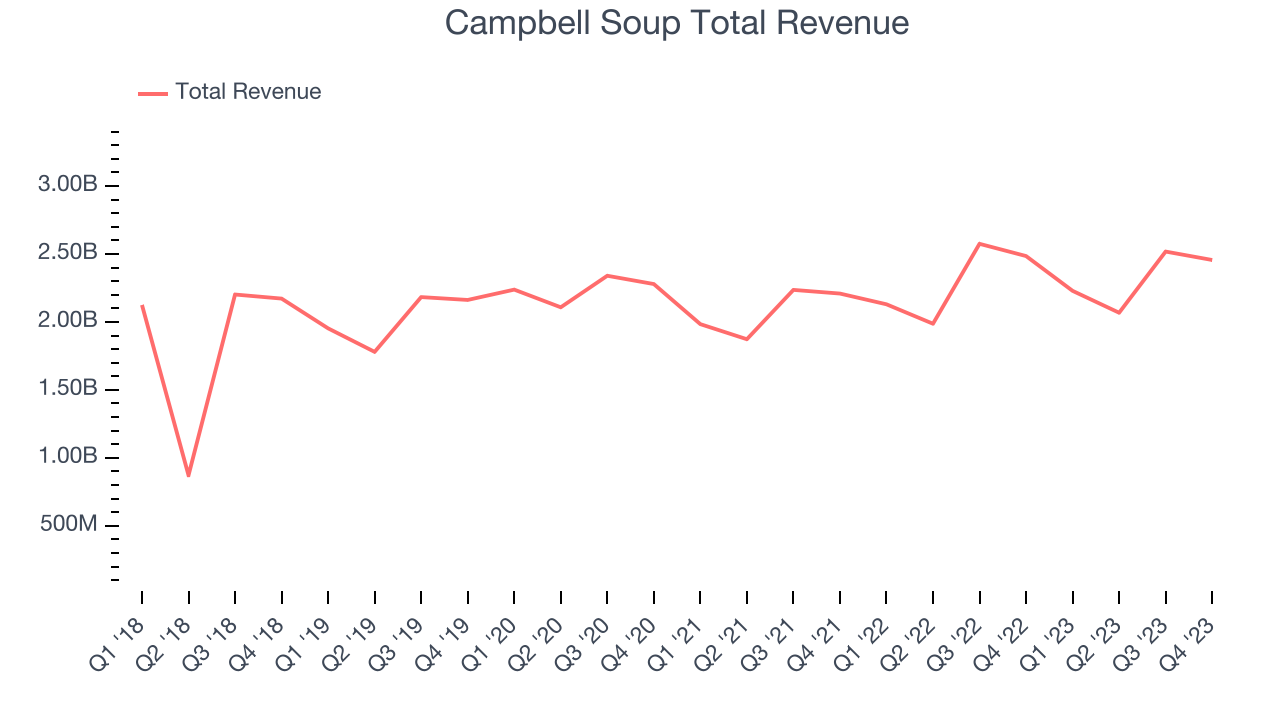
This quarter, Campbell Soup reported a rather uninspiring 1.2% year-on-year revenue decline to $2.46 billion in revenue, in line with Wall Street's estimates. Looking ahead, Wall Street expects sales to grow 1.7% over the next 12 months, an acceleration from this quarter.
Volume Growth
Revenue growth can be broken down into changes in price and volume (the number of units sold). While both are important, volume is the lifeblood of a successful staples business as there’s a ceiling to what consumers will pay for everyday goods; they can always trade down to non-branded products if the branded versions are too expensive.
To analyze whether Campbell Soup generated its growth from changes in price or volume, we can compare its volume growth to its organic revenue growth, which excludes non-fundamental impacts on company financials like mergers and currency fluctuations.
Over the last two years, Campbell Soup's average quarterly sales volumes have shrunk by 3.6%. This decrease isn't ideal as the quantity demanded for consumer staples products is typically stable. Luckily, Campbell Soup was able to offset fewer customers purchasing its products by charging higher prices, enabling it to generate 6.4% average organic revenue growth. We hope the company can grow its volumes soon, however, as consistent price increases (on top of inflation) aren't sustainable over the long term unless the business is really really special. 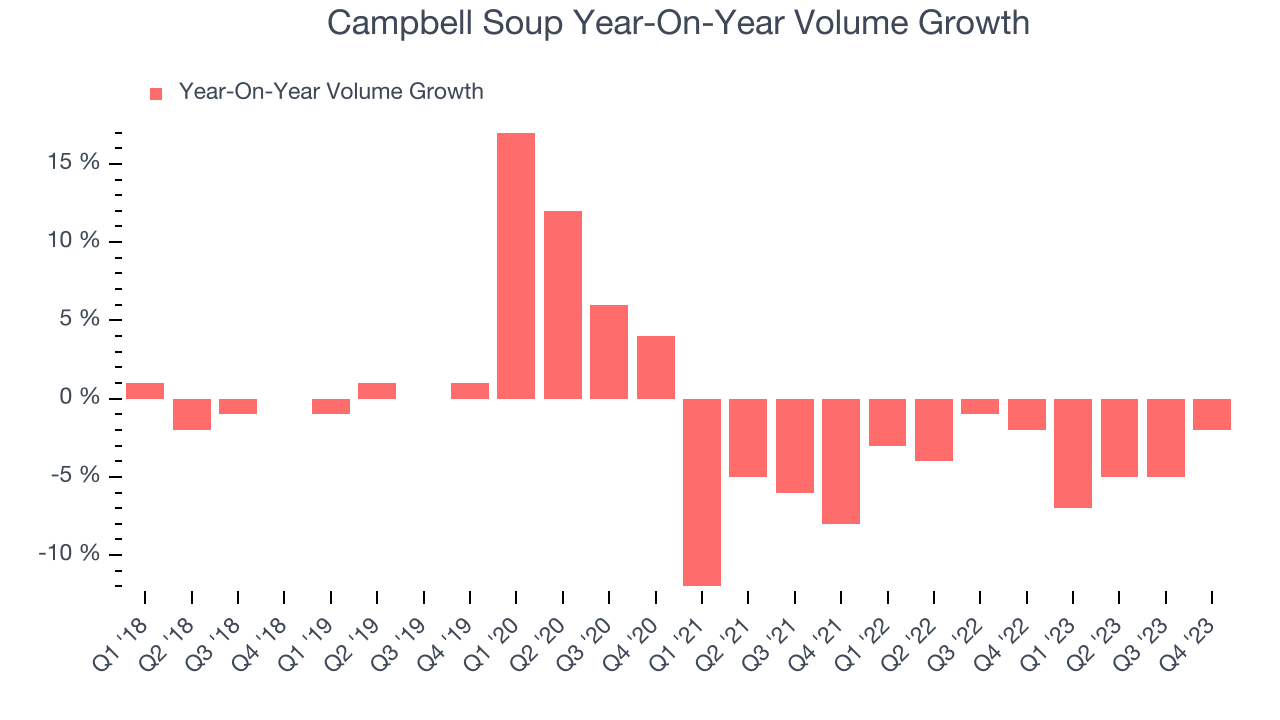
In Campbell Soup's Q2 2024, sales volumes dropped 2% year on year. This result was a further deceleration from the 2% year-on-year decline it posted 12 months ago, showing the business is struggling to push its products.
Gross Margin & Pricing Power
All else equal, we prefer higher gross margins. They usually indicate that a company sells more differentiated products and commands stronger pricing power.
This quarter, Campbell Soup's gross profit margin was 31.6%, up 1.1 percentage points year on year. That means for every $1 in revenue, $0.68 went towards paying for raw materials, production of goods, and distribution expenses. 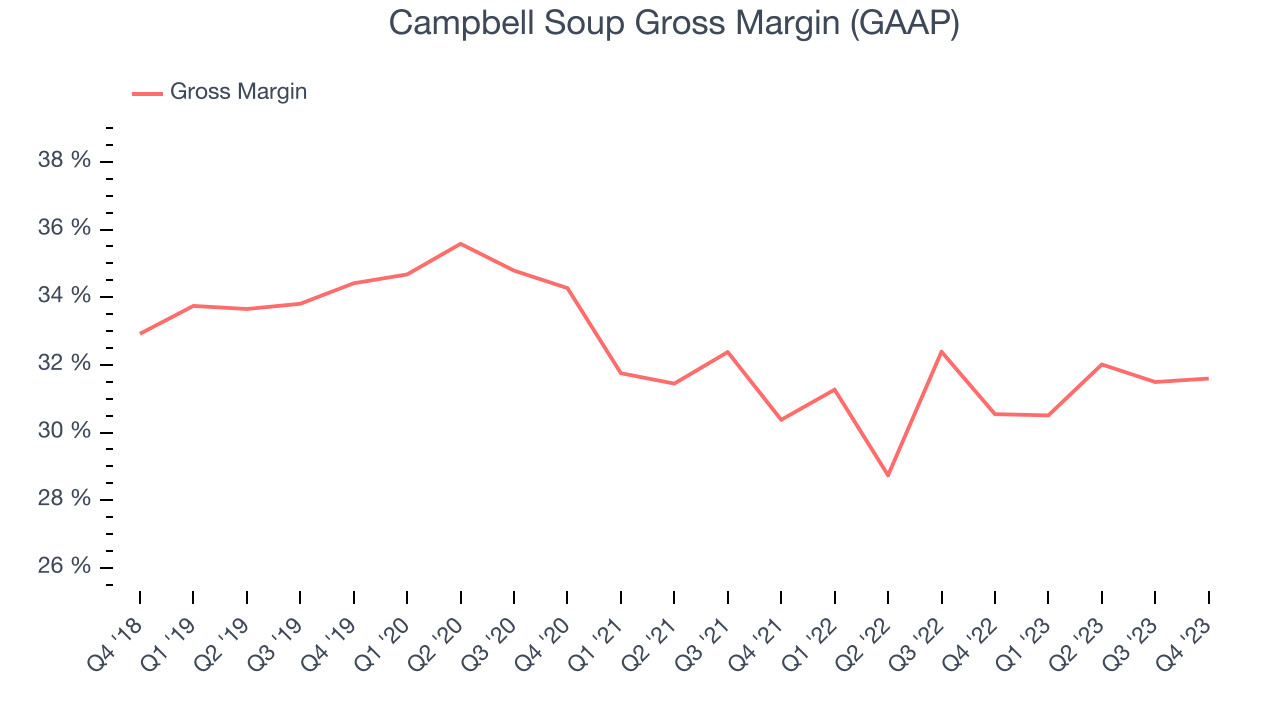
Campbell Soup's unit economics are higher than the typical consumer staples company, giving it the flexibility to invest in areas such as marketing and talent to reach more consumers. As you can see above, it's averaged a decent 31.1% gross margin over the last eight quarters. Its margin has also been trending up over the last 12 months, averaging 2.4% year-on-year increases each quarter. If this trend continues, it could suggest a less competitive environment where the company has better pricing power and more favorable input costs (such as raw materials).
Operating Margin
Operating margin is a key profitability metric for companies because it accounts for all expenses enabling a business to operate smoothly, including marketing and advertising, IT systems, wages, and other administrative costs.
In Q2, Campbell Soup generated an operating profit margin of 12.9%, down 1.2 percentage points year on year. Conversely, the company's gross margin actually increased, so we can assume the reduction was driven by a step up in discretionary spending in areas like corporate overhead and advertising.
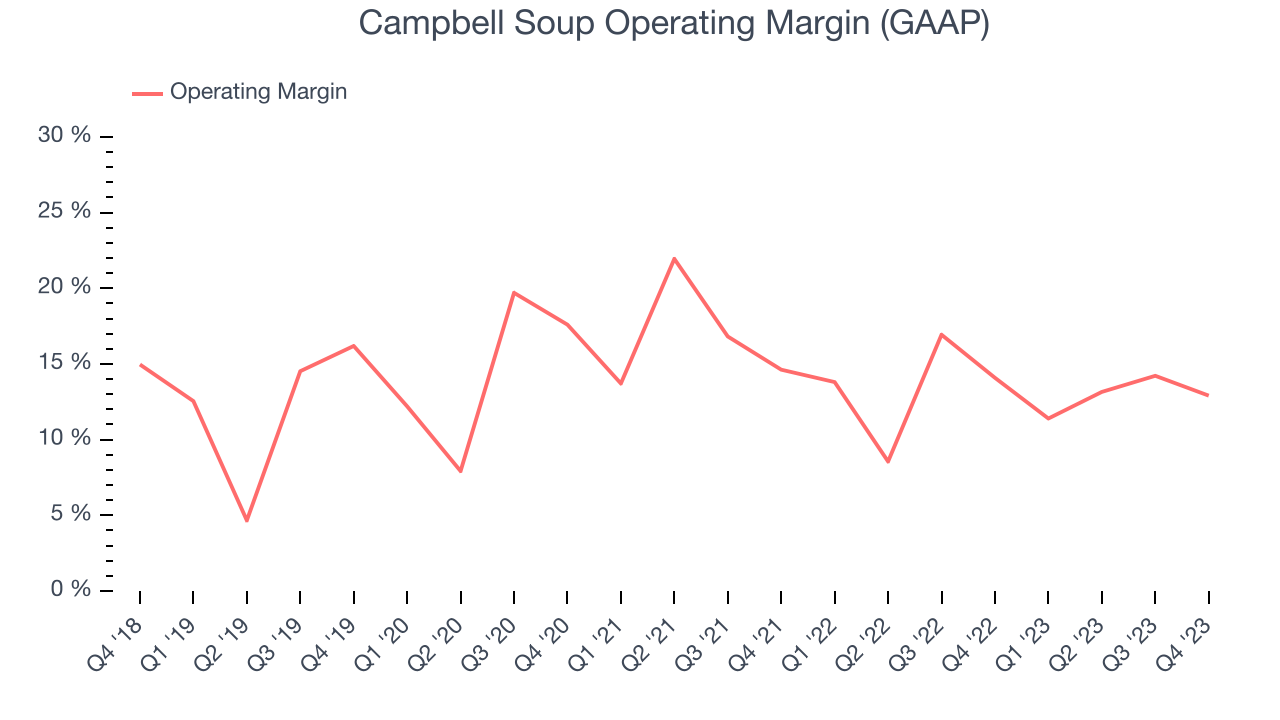 Zooming out, Campbell Soup has managed its expenses well over the last two years. It's demonstrated solid profitability for a consumer staples business, producing an average operating margin of 13.3%. On top of that, its margin has remained more or less the same, highlighting the consistency of its business.
Zooming out, Campbell Soup has managed its expenses well over the last two years. It's demonstrated solid profitability for a consumer staples business, producing an average operating margin of 13.3%. On top of that, its margin has remained more or less the same, highlighting the consistency of its business. EPS
Earnings growth is a critical metric to track, but for long-term shareholders, earnings per share (EPS) is more telling because it accounts for dilution and share repurchases.
In Q2, Campbell Soup reported EPS at $0.80, in line with the same quarter a year ago. This print beat Wall Street's estimates by 3.9%.
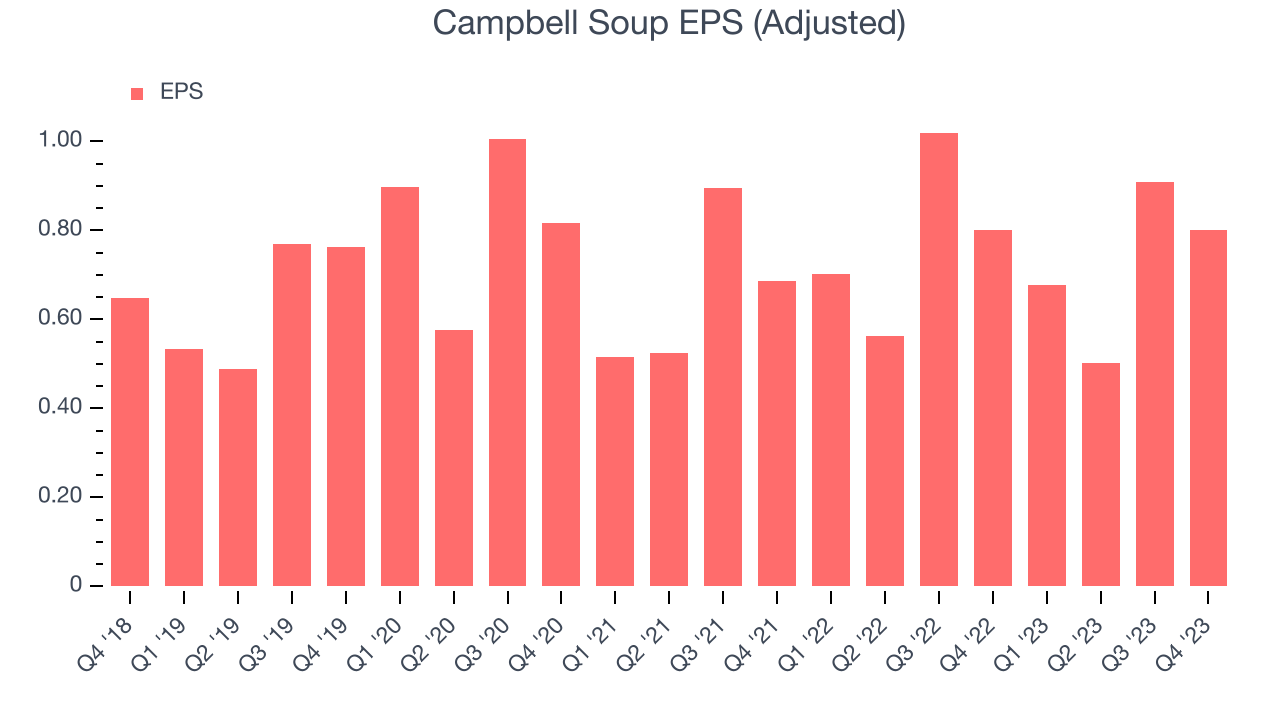
Between FY2021 and FY2024, Campbell Soup's EPS dropped 12.4%, translating into 4.3% annualized declines. We tend to steer our readers away from companies with falling EPS, especially in the consumer staples sector, where shrinking earnings could imply changing secular trends or consumer preferences. If there's no earnings growth, it's difficult to build confidence in a business's underlying fundamentals, leaving a low margin of safety around the company's valuation (making the stock susceptible to large downward swings).
On the bright side, Wall Street expects the company's earnings to grow over the next 12 months, with analysts projecting an average 8.9% year-on-year increase in EPS.
Cash Is King
Although earnings are undoubtedly valuable for assessing company performance, we believe cash is king because you can't use accounting profits to pay the bills.
Campbell Soup's free cash flow came in at $390 million in Q2, down 8.7% year on year. This result represents a 15.9% margin.
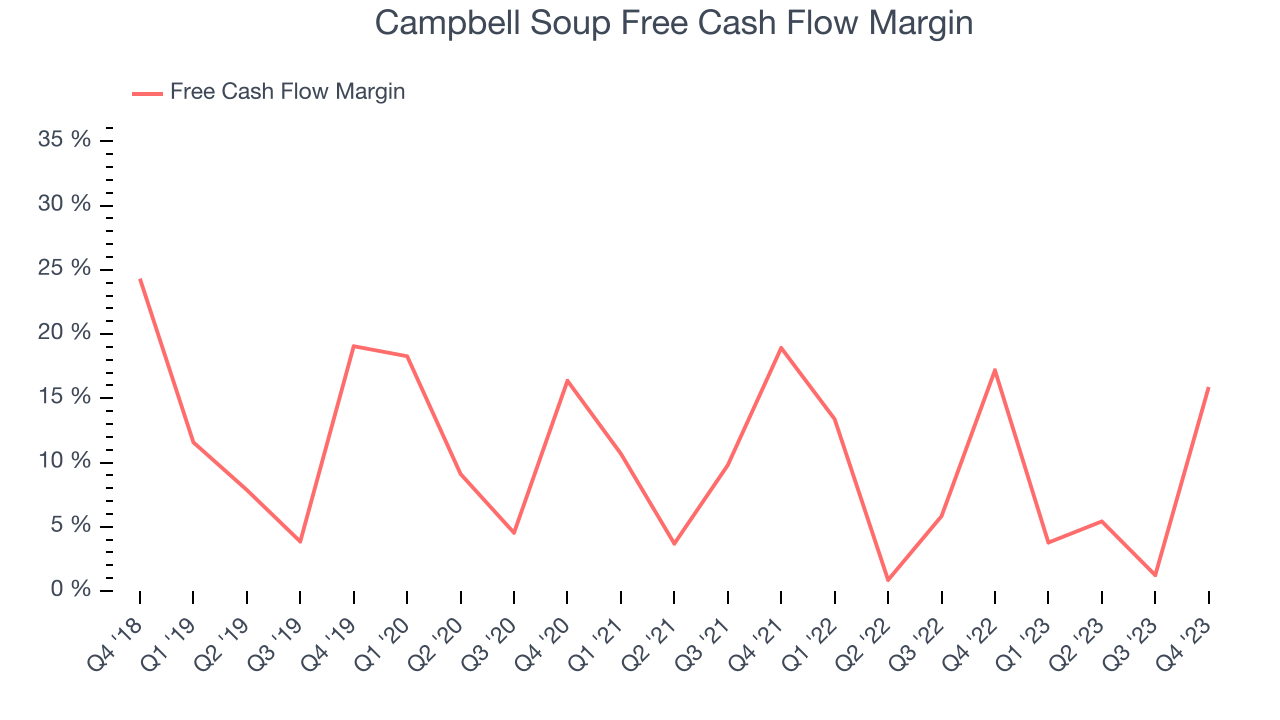
Over the last eight quarters, Campbell Soup has shown solid cash profitability, giving it the flexibility to reinvest or return capital to investors. The company's free cash flow margin has averaged 8.1%, above the broader consumer staples sector. However, its margin has averaged year-on-year declines of 2.9 percentage points over the last 12 months. If this trend continues, it could signal that the business is becoming slightly more capital-intensive.
Return on Invested Capital (ROIC)
EPS and free cash flow tell us whether a company was profitable while growing revenue. But was it capital-efficient? A company’s ROIC explains this by showing how much operating profit a company makes compared to how much money the business raised (debt and equity).
Campbell Soup's five-year average ROIC was 12.2%, slightly better than the broader sector. Just as you’d like your investment dollars to generate returns, Campbell Soup's invested capital has produced decent profits.
The trend in its ROIC, however, is often what surprises the market and drives the stock price. Uneventfully, Campbell Soup's ROIC stayed the same over the last two years. This is fine because its returns are solid, but if the company wants to become an investable business, it will need to increase its ROIC even more.
Key Takeaways from Campbell Soup's Q2 Results
It was great to see Campbell Soup beat analysts' EPS expectations this quarter, though its sales volumes declined (albeit to a lesser extent than forecasted by Wall Street). With its lower volumes, the company's full-year 2024 revenue guidance fell short, but its full-year EPS guidance exceeded estimates.
Furthermore, Cambell Soup's pending acquisition of Sovos Brands is expected to close the week of March 11th and is not currently baked into its outlook. Sovos Brands' products include Rao's Homemade pasta sauce and Noosa Yoghurt.
Overall, this quarter's results were mixed as its sales were weak but its earnings were better than expected. The stock is flat after reporting and trades at $43.15 per share.
Is Now The Time?
Campbell Soup may have had a favorable quarter, but investors should also consider its valuation and business qualities when assessing the investment opportunity.
We cheer for all companies serving consumers, but in the case of Campbell Soup, we'll be cheering from the sidelines. Its revenue growth has been weak over the last three years, but at least growth is expected to increase in the short term. And while its well-known brand makes it a household name consumers consistently turn to, the downside is its shrinking sales volumes suggest it'll need to change its strategy to succeed. On top of that, its declining EPS over the last three years makes it hard to trust.
Campbell Soup's price-to-earnings ratio based on the next 12 months is 13.6x. While the price is reasonable and there are some things to like about Campbell Soup, we think there are better opportunities elsewhere in the market right now.
Wall Street analysts covering the company had a one-year price target of $46.48 per share right before these results (compared to the current share price of $43.15).
To get the best start with StockStory, check out our most recent stock picks, and then sign up to our earnings alerts by adding companies to your watchlist here. We typically have the quarterly earnings results analyzed within seconds of the data being released, and especially for companies reporting pre-market, this often gives investors the chance to react to the results before the market has fully absorbed the information.
